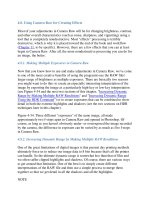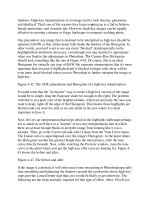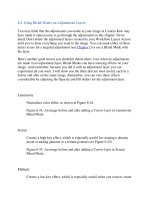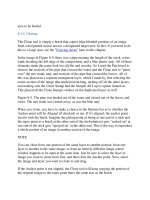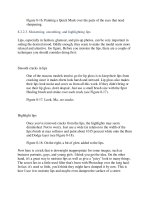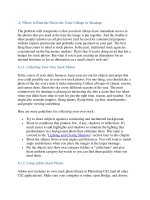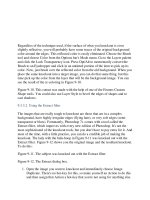Professional Information Technology-Programming Book part 19 potx
Bạn đang xem bản rút gọn của tài liệu. Xem và tải ngay bản đầy đủ của tài liệu tại đây (24.64 KB, 5 trang )
4.8. Using Camera Raw for Creating Effects
Most of your adjustments in Camera Raw will be for changing brightness, contrast,
and other overall characteristics (such as noise, sharpness, and vignetting) using a
tool that is completely nondestructive. Most "effects" processing is terribly
destructive, which is why it is placed toward the end of the book and workflow
(Chapter 11, to be specific). However, there are a few effects that you can at least
begin in Camera Raw. After all, the more nondestructive processing you can do for
an image, the better.
4.8.1. Making Multiple Exposures in Camera Raw
Now that you know how to use and make adjustments in Camera Raw, we've come
to one of the more creative benefits of using the programto use the RAW files'
larger range of brightness as multiple exposures. There are basically two reasons
you might want to do this: to create an especially interesting interpretation of the
image by exporting the image as a particularly high-key or low-key interpretation
(see Figure 4-34 and the next two sections of this chapter, "Increasing Dynamic
Range by Making Multiple RAW Renditions" and "Increasing Dynamic Range
Using the HDR Command") or to create exposures that can be combined to show
detail in both the extreme highlights and shadows (see the two sections on HDR
techniques later in this chapter).
Figure 4-34. Three different "exposures" of the same image, all made
approximately two f-stops apart in Camera Raw and opened in Photoshop. Of
course, as long as you haven't obviously under- or overexposed the image recorded
by the camera, the difference in exposure can be varied by as much as five f-stops
in Camera Raw.
4.8.2. Increasing Dynamic Range by Making Multiple RAW Renditions
One of the great limitations of digital images is that present day printing methods
ultimately force us to reduce our image data to 8 bits because that's all the printer
can handle. So the ultimate dynamic range is somewhat less than that of film and
we often suffer clipped highlights and shadows. Of course, there are various ways
to get around that limitation. One of the best is to simply create different
interpretations of the RAW file and then use a simple process to merge them
together so that we get detail in all the shadows and all the highlights.
NOTE
Most of the time, I actually prefer this method instead of Photoshop's HDR
command (discussed in the "Increasing Dynamic Range Using the HDR
Command" section next). With this method, you're not limited to static subjects
because you're making a pair of interpretations of the exact same moment that,
when combined, show pretty much all the brightness and tone that you could
possibly see. Also, it is easier to previsualize and produce the end result.
In Figure 4-35, I use a photo of a forest just because there's so much brightness
detail in that type of subject, but the nature of the actual subject matter matters
little. One thing you should be extra careful of is to watch your camera's Histogram
to make sure that all the tones are inside it. The process is as follows:
Figure 4-35. The low-key and high-key "exposures" of the same RAW file.
1. Go to Bridge and open your image in Camera Raw. When you see the image
in the Camera Raw workspace, press Cmd/Ctrl-U until all the Auto
checkboxes are turned off. Then create a low-key exposure, but don't worry
too much about keeping detail in the shadows. The overall image should
look as though it's about two stops underexposed. The most important thing
is to be sure that you see plenty of detail in the Highlights. When you like
what you see in the Preview window, click Open. Your low-key image will
open in Photoshop. Be sure to leave it open.
2. Reopen Bridge and reopen the same file in Camera Raw. This time, make
the adjustments so that you see plenty of detail in the darker midtones and
the shadows. These shadows are going to replace the shadows in the
previous (low-key) interpretation you just made, so make sure they contain
plenty of detail. At the same time, make sure that anything that needs to be
black is black. The best way to do this is to turn on the Shadows preview
box. You can see the results of both exposures in Figure 4-35.
3. Click inside the overexposed or high-key image so that it's active and then
choose Select Color Range. The Color Range dialog appears (see Figure
4-36).
Figure 4-36. The Color Range dialog.
4. Choose Highlights from the Select menu. When the selection marquee
appears, click OK.
5. Choose Select Feather. Enter a feather radius large enough to give you
plenty of blending. I find that something around 150 pixels generally works
best for merging markedly different dynamic ranges, such as we have here,
but you will have to experiment on individual images to get the best result. If
you select a feather radius that is too large, you'll lose a lot of detail in the
midtones. If the feather radius is too small, you'll get very unrealistic halos
around darker-toned objects.
6. Press Cmd/Ctrl-I to invert the selection and then Cmd/Ctrl-C to copy the
contents of the selection to the clipboard.
7. Make the low-key image active by clicking inside it. Press Cmd/Ctrl-V to
paste the contents of your selection layer into the low-key image. You can
see the final result in Figure 4-37.
Figure 4-37. The Camera Raw Auto adjustment of the file (left) and the
"fake" HDR result after the merge of both Camera Raw exposures (right).
4.8.3. Increasing Dynamic Range Using the HDR Command
Although you can create HDR files from other formats, they work best when
created from RAW files, thanks to the extended range of data already in those files.
The exercise described here works best when you use a series of three to five RAW
files taken two full f-stops apart. The camera should be on a tripod, you should use
a remote shutter trigger (or cable release), and your subject must be still as a stone.
You must not change the aperture or focus, so it's best to shoot in Manual mode for
both exposure and focus and to shoot in RAW mode.
Once you've done all that, upload the pix to your computer. Although it's possible
to process HDRs directly from the Bridge Tools menu, don't. You'll get much
better results from the following sequence of steps:
NOTE
If your camera can shoot a sequence two full f-stops apart in a bracketed sequence,
you may be able to shoot an HDR sequence without a tripod (but you still need to
be very steady when shooting). Be sure to put the camera in Aperture Priority
mode to force the bracketing by shutter speed, rather than by changing aperture or
ISO. It will help a lot if you can at least brace the camera against a lamppost, tree,
or railing. At the very least, don't breathe or wiggle in the slightest. If you do risk
handheld sequences, be sure to check the Auto-overlap box in the Merge to HDR
dialog that opens when you choose File Automate Merge to HDR.
1. In Bridge, select the images you want to merge, then press Enter/Return to
open them in Camera Raw.
2. Click the Select All button to select the entire sequence. If you think there
are too many in the set or that some exposures are too close together, press
Cmd/Ctrl and deselect those you don't want to include.
3. Press Cmd/Ctrl-U once or twice until all the Auto boxes are turned off. You
should now see a distinct one or (better) two-stop difference between the
brightness of each of the thumbnails.
4. Leaving the chosen thumbs selected, click the Open button. Each image will
open in a separate window in Photoshop.
5. In Photoshop, choose File Automate Merge to HDR. A Merge to
HDR dialog that looks similar to the Camera Raw multiple exposure dialog
will open. Be sure to click the Attempt to Automate box at the bottom if you
attempted to shoot a handheld sequence. From the Use menu, choose Open
Files. Click OK. Wait and watch.
6. After a few frames have popped up, they'll give way to a full screen dialog
called Merge to HDR. (See Figure 4-38.) You'll see the images you picked
fill the screen. On the left are the thumbs of the RAW images you picked
just as the camera recorded them, with no adjustment. In the center, you'll
see the results of the merge. On the right, you see a bit depth menu, a
Histogram, and a slider. Move the slider until the overall brightnessand the
white pointare exactly where you want them to be. Never mind if this image
itself looks weak in the shadow tones. Leave the Bit Depth menu choice at
32 bits.
Figure 4-38. The Merge to HDR dialog.
NOTE
You can click the Browse button and browse for files to include in the
merge, but there's no way to visually identify RAW files because there are
no thumbnails.
7. A new file opens that is titled Untitled HDR. If you want to save up your
image for the day when you can actually make use of all that brightness
information in some future version of Photoshop, save the file as a Portable
Bit Map file.
8. You now have two choices for finally adjusting the file. If you want to adjust
it in 32 bits, your only choice is Image Adjust Exposure. You can see
the Exposure dialog in Figure 4-39. The Exposure dialog pops up. Drag the
sliders until you like what you see and click OK.
Figure 4-39. The Exposure dialog.
If you want to use the usual adjustment commands, you'll have to convert
the file to 16 bits. You can convert to 8 bits, but why throw out that much
data when you've gone through the trouble to collect it? At least keep it to 16
bits until you've finished doing all your work on the file. Then you can make
a copy, flatten the layers, and reduce the bit depth for publication without
destroying all the work you did on the original, which you may want to
change someday without having to do it all over again. Choose Image
Mode 16 bits. An HDR Conversion dialog appears, as shown in Figure 4-
40.
Figure 4-40. The HDR Conversion dialog.
9. You now have several methods you can choose from to interpret the final
version of the image. You'll probably find Exposure and Gamma the most
useful. The sliders are extremely sensitive, so start by getting the Exposure
adjusted to something close to what you want as an end result. Now adjust
the overall contrast with the Gamma slider. These are subjective
adjustments, so just experiment until you like the results. You can see my
results from the original images I shot in Figure 4-41.
Figure 4-41. The final result from the Exposure and Gamma dialog. Of
course, you'd crop out the railing, but not until further along the workflow.
Since you now have a standard 16-bit Photoshop file to work with, you can use any
of the Photoshop commands to further enhance this image. Of course, some
Photoshop commands and adjustments work only in 8-bit mode, so you should
wait until you're further along in the workflow before applying those commands or
you'll lose a large percentage of your brightness information.
4.8.4. Create a High-Key Version of the Image
High-key images are those that are very bright in tone and have few (if any) deep



